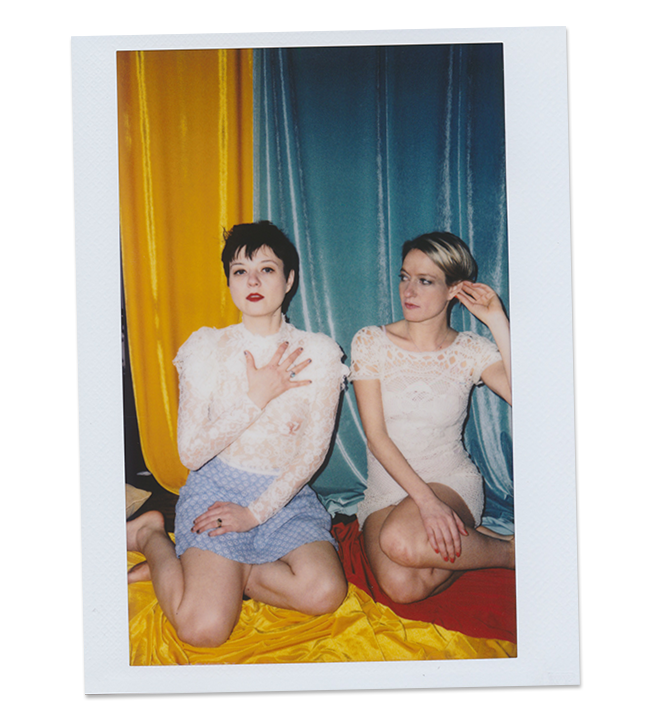The Girls Who Fell To Earth
For our newest short, Kelsey and Rémy Bennett highlight 17-year-old artist Panteha Abareshi’s journey from hospital patient to IRL goddess. Now, we spend an evening with the pair to discuss photography, doc life, and the thin line in art between creativity and compassion.
Behind the scenes with filmmaking duo Kelsey and Rémy Bennett, creators of our newest doc The Girl Who Loves Roses
By Staff
Unpopular opinion, but New York City’s art fair season, generally the first week of March, is a snooze. After walking through your third “immersive sculptural work” or “visionary painting manifesto” even the most seasoned art-world veteran is ready to get “immersed” in a strong happy hour. But at the 2016 Spring Break Art Show, we experienced some relief from the overwhelming monotony by accidentally stumbling into the bedroom of an adolescent satanist going through some series growing pains. Part of Glory Hole, a 9-person installation “exploring the subversions of intimacy, sexual catharsis, worship, exhibitionism, and violence” curated by Kelsey and Rémy Bennett and Kaitlyn Parks, it featured walls spray painted with pentagrams next to defaced pop idol posters and a whole other assortment of trashed, teen ephemera. We later learned the scene was based on Bennett’s short cam-girl-turned-cannibal thriller Eat Me, co-written with friend and former Broadly writer Anna del Gaizo. The piece, which perfectly walked the line between the ridiculously girly and the fucking terrifying, stayed with us like an art-induced drug trip.
Recently, we had the chance to come across the Bennett sister’s work again when The FRONT teamed up with the pair for The Girl Who Loves Roses, our short doc on the life and work of 17-year-old artist Panteha Abareshi. In the film, they explore Abareshi’s struggles with Sickle Cell Beta Zero Thalassemia, depression and anxiety, and how she’s used illustration and wild explorations of the mind to transcend her sometimes limited physical abilities.The doc debuts this week on The FRONT in tandem with Abareshi’s first solo show, a two-week pop-up installation at the female run-and-operated Larrie NYC gallery in Chinatown.
Together, Rémy and Kelsey have frequently worked as a curatorial team, with past projects also including the 24-woman strong LIFEFORCE, a celebration of raw and messy femininity, as well as the art show displayed at the pivotal end sequence of Weiner Dog, Todd Solondz’s 2016 tart paean to love, aging and friendship. Rémy, who studied with Lee Strasberg at age 12 and later at the Central School of Speech and Drama in London, acted in The Wolf of Wall Street and Boardwalk Empire. She also co-wrote, directed, and starred in Buttercup Bill (2014), a Lynchian psycho-sexual thriller that screened at the Marfa Film Festival, released via actress Sadie Frost’s Blonde to Black Pictures. Behind the camera, she directed video content for fashion brands such as Zac Posen, Converse, Tommy Hilfiger, and Gloria Vanderbilt, and is currently working on a doc about true crime writer John Gilmore. Kelsey Bennett, who regularly shoots a polaroid series for Interview Magazine, has contributed to a range of outlets including VICE, Bullett, and Dazed, and has shot everyone from a celebrated James Brown impersonator, floating through his daily routine, to Amy Winehouse and Lady Gaga, captured on the road with her grandfather, the iconic singer Tony Bennett.
The sisters have actually been collaborating on film and photo projects since early childhood—“I used to dress Rém up in little outfits and take pictures.” Now, the pair are joined again for a larger project, highlighting women traditionally marginalized, misunderstood, or altogether ignored by mass media. “Art by women is more important now in our political climate than ever,” says Kelsey. “We wanted to emphasize that but also explore how these artists work as artists, apart from just the label of ‘women artists’.”
“She [Abareshi] wanted to turn the concept of romance on its head. With the symbol of a rose, she reclaims it as something that has to do with power and respect and identity, versus love”
The first in this series is our short on Abareshi, whose excruciating condition forced her to leave school for long periods of hospitalization. She then entered into a sort of bizarro artistic residency, where hours were spent creating work, discovering and exploring the limits of illustration. The results were a series of pieces that draw on everything from her experiences with anxiety and depression to her own Jamaican/Iranian heritage, transporting viewers into a graphic world of goddesses, female empowerment, pain and..roses. “She’s very into the idea of ‘anti-romance’,” explains Kelsey. “She wanted to turn the concept of romance on its head. With the symbol of a rose, she reclaims it as something that has to do with power and respect and identity, versus love”. Hence, the name of our doc.
The duo first came across Abareshi’s work on the internet zine Polyester while scouting for LIFEFORCE. “Her work was female-driven, but all about transcending identity. Irreverence, violence, humor, the grotesque. It was transcending norms, but through a lot of in-your-face anarchic ideas. She just encompasses that completely.” They were instantly enchanted by the precocious illustrator with a bold aesthetic, and saw in her work the darkly humorous take on romance, gender, and race they’d been looking for. “Automatically, the 3 of us just really hit it off. We totally got each other.”
For The FRONT’s doc, Abareshi flew out to New York, ostensibly to star in the shoot but later throwing herself into set design work, pulling fabric and props along with the team, despite her illness. “She just wanted to be a part of everything,” Rémy laughs. “We actually had to tell her take it easy.” Since Abareshi is still at the very beginning stages of her career, the duo recognized the immense opportunity they had to observe an artist at the very moment she discovers her talents. We imagine it’s a little like watching a baby chick hatch—only that chick draws radically self-empowered deities and has a passion for Norse Mythology and gore.
“She’s into embracing what people might consider ‘gross’ and reclaiming it,’ says Kelsey, discussing Abareshi. “Because she is expressing pain, and there’s no other way to do that.”
The two filmmakers aren’t exactly new to the grotesque. Both longtime horror fans, and inspired by films like Halloween and Suspiria, Rémy would write, produce, direct, and even create makeup design schemes in high school for amateur horror shots. “Every day after school I would try to make the perfect bruise or scar. I spent weeks trying to make the perfect vomit!”
In this film, however, they drew more on Abareshi own muses. “When she was in the hospital, she had fantasies about becoming different people. Since both me and Rém work mostly with the conceptual, we loved the idea of recreating and art directing those fantasies. We were talking about her influences, which ranged from goddesses to Sigourney Weaver in Aliens. Her whole vibe was ‘I want to create a female that is strong and powerful and badass and has metal on them maybe and is not necessarily sexual but is fierce and grotesque.’”
The result is something akin to Erykah Badu traveling up Holy Mountain—but if she also moonlighted as a prize fighter. Several of the images in the film capture Abareshi assuming the stance of a boxer, covered in fake blood, upper lip snarled in defiance.
“She’s this case study, developmentally, emotionally and intellectually, of when you have no time to waste,” Rémy explains. “When your mortality is such a reality at that age, it forces you to get to work.”
“In her father’s [Iranian culture], when a child is born it’s the tradition to bury the umbilical cord in a place of intention. For instance, if you want your child to grow up and become a doctor, you would bury it outside of a hospital. For a professor, outside a university. But her father decided to bury her umbilical at the beginning of a maze, I’itoi in the Arizona desert, with the idea that you should walk through life knowing that you will be confronted with many struggles, and from those struggles you will attain wisdom. This is all before you get to the center, which represents death. So her father had basically already set her on this very surrealistic path—which was almost too perfect.” Despite this rather prescient origin story, Abareshi is much like a regular teen, exploring colleges for the fall and refining her ideas on life.
“I love losing myself in somebody else,” Kelsey ultimately explains about documentary film and photo, a process which can often take years to complete and yield little to no financial rewards. “When you’re able to explore something, explore someone else’s mind and what motivates them to do what they do and where they come from? It’s the most supremely rewarding feeling,” she says. “where Rém and I come from, artistically— ha, also sharing the same womb!—it made a lot of sense to be collaborating on something where we get to embrace somebody else’s world.”
Larrie NYC
27 Orchard St.
New York, NY 10002
Hours
Monday: Closed
Tuesday – Sunday: 10 – 6
All Photos courtesy of Tafv Sampson ( http://www.tafvsampson.com/)
Text by Laura Feinstein



